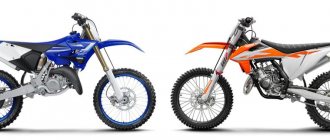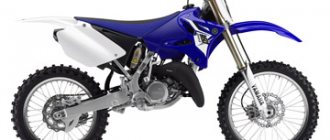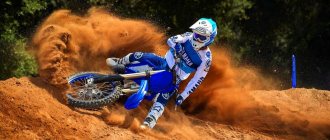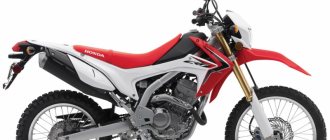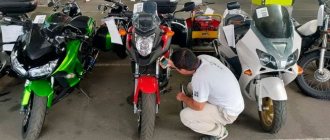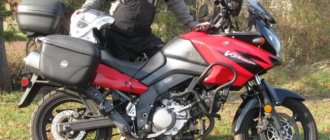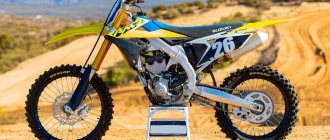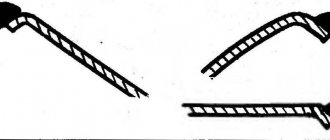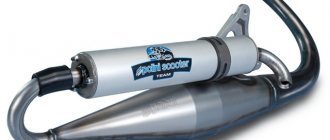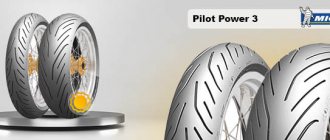| Yamaha YZ125 (1988) (+ steel frame, regular fork) | Yamaha YZ125 (1989~) (+ inverted fork) | Yamaha YZ125 (2005~) (+ aluminum frame) |
| Yamaha YZ125 (2007~) (+ petal rims) | Yamaha YZ125 (2017-2021) (+ front brake disc 250 → 270 mm) | Yamaha YZ125 (2022+) |
| Yamaha YZ125 Monster Energy Yamaha Racing Edition (2022) |
Model of motocross motorcycle Yamaha YZ125
begins its history in 1974 - then it was an archaic (by modern standards) motorcycle with an air-cooled engine and double shock absorbers at the rear, which bore little resemblance to cross-country models in the modern sense. Only by the end of the 80s of the last century did the Yamaha YZ 125 acquire modern features, and by 1989 - an inverted fork. In our review, we will consider models starting from 2005, when the motorcycle received a modern aluminum frame.
Since 2006, the motorcycle has been equipped with a new KYB SSS (Speed-Sensitive System) front fork.
In 2007, the Yamaha YZ125 model undergoes minor changes, the main of which are new petal brake discs, and in 2021 - an increased front disc diameter (from 250 to 270 mm). At the end of 2021, Yamaha introduced the new generation YZ125. The updated version received a new engine, improvements to the braking system (weight reduction, use of stiffer pads, the diameter of the rear brake disc is reduced from 245 → 240 mm), ergonomics, suspension settings, intake system, as well as a new Keihin PWK38S carburetor (instead of the Mikuni TMX38).
Among the features of the Yamaha YZ125, it is worth highlighting a 2-stroke liquid-cooled engine with a power valve system (YPVS), an aluminum frame (since 2005), sports adjustable suspension, an 8-liter fuel tank, a carburetor power system and 94 kg of curb weight.
In 2001, Yamaha introduced a 4-stroke version of the Yamaha YZ250F, which was intended to replace similar 2-stroke models, but the YZ125 still continues to be sold in parallel and can compete in the same racing class.
The main competitors of the Yamaha YZ 125 in the class:
- Honda CR125R
- Kawasaki KX125
- Suzuki RM125
Brief history of the model
- 1974 - Model
: Yamaha YZ125 (USA).
Factory designation
: YZ125A.
- 1975 - Model
: Yamaha YZ125 (USA).
Factory designation
: YZ125B.
- 1976 - Model
: Yamaha YZ125;
Yamaha YZ125X (USA). Factory designation
: YZ125C.
- 1977 - Model
: Yamaha YZ125 (USA).
Factory designation
: YZ125D.
- 1978 - Model
: Yamaha YZ125 (USA).
Factory designation
: YZ125E.
- 1979 - Model
: Yamaha YZ125 (USA).
Factory designation
: YZ125F.
- 1980 - Model
: Yamaha YZ125 (USA).
Factory designation
: YZ125G.
- 1981 - Model
: Yamaha YZ125 (USA).
Factory designation
: YZ125H.
- 1982 - Model
: Yamaha YZ125 (USA).
Factory designation
: YZ125J.
- 1983 - Model
: Yamaha YZ125 (USA).
Factory designation
: YZ125K.
- 1984 - Model
: Yamaha YZ125 (USA).
Factory designation
: YZ125L.
- 1985 - Model
: Yamaha YZ125 (USA).
Factory designation
: YZ125N.
- 1986 - Model
: Yamaha YZ125 (USA, Europe).
Factory designation
: YZ125S, 1LX, 1LX0.
- 1987 - Model
: Yamaha YZ125 (USA, Europe).
Factory designation
: YZ125T, 2HG.
- 1988 - Model
: Yamaha YZ125 (USA, Europe).
Factory designation
: YZ125U, 2VN.
- 1989 - Model
: Yamaha YZ125 (USA, Europe).
Factory designation
: YZ125W, 3JD1.
- 1990 - Model
: Yamaha YZ125 (All markets).
Factory designation
: YZ125A, 3SR1, 3SR2, 3SR3, 3SR4.
- 1991 - Model
: Yamaha YZ125 (All markets).
Factory designation
: YZ125B, 3XJ1, 3XJ2, 3XJ3, 3XJ4.
- 1992 - Model
: Yamaha YZ125 (All markets).
Factory designation
: YZ125D, 4DB1, 4DB2, 4DB3, 4DB4.
- 1993 - Model
: Yamaha YZ125 (All markets).
Factory designation
: YZ125E, 4EX1, 4EX2, 4EX3, 4EX4.
- 1994 - Model
: Yamaha YZ125 (North America, Europe, Japan).
Factory designation
: YZ125F, 4JY1, 4JY2, 4JY3, 4JY4.
- 1995 - Model
: Yamaha YZ125 (All markets).
Factory designation
: YZ125G, 4PE1, 4PE2, 4PE3, 4PE4.
- 1996 - Model
: Yamaha YZ125 (All markets).
Factory designation
: YZ125H, 4SS1, 4SS2, 4SS3, 4SS4.
- 1997 - Model
: Yamaha YZ125 (All markets).
Factory designation
: YZ125J, 4XM1, 4XM2, 4XM3, 4XM4.
- 1998 - Model
: Yamaha YZ125 (All markets).
Factory designation
: YZ125K, 5DH1, 5DH2, 5DH3, 5DH4.
- 1999 - Model
: Yamaha YZ125 (All markets).
Factory designation
: YZ125L, 5ET1, 5ET2, 5ET3.
- 2000 - Model
: Yamaha YZ125 (All markets).
Factory designation
: YZ125M, 5HD1, 5HD2, 5HD3, 5HD4.
- 2001 - Model
: Yamaha YZ125 (All markets).
Factory designation
: YZ125N, 5MV1, 5MV2, 5MV3, 5MV4.
- 2002 - Model
: Yamaha YZ125 (All markets).
Factory designation
: YZ125P, 5NY1, 5NY2, 5NY3, 5NY4.
- 2003 - Model
: Yamaha YZ125 (All markets).
Factory designation
: YZ125R, 5UN1, 5UN2, 5UN3, 5UN4.
- 2004 - Model
: Yamaha YZ125 (All markets).
Factory designation
: YZ125S, 5XE1, 5XE2, 5XE3, 5XE4.
- 2005 - Model
: Yamaha YZ125 (All markets).
Factory designation
: YZ125T1, 1C31, 1C32, 1C33, 1C34.
- 2006 - Model
: Yamaha YZ125 (All markets).
Factory designation
: YZ125V, 1C35, 1C36, 1C37, 1C38.
- 2007 - Model
: Yamaha YZ125 (All markets).
Factory designation
: YZ125W1, 1C39, 1C3A, 1C3B, 1C3C.
- 2008 - Model
: Yamaha YZ125 (All markets).
Factory designation
: YZ125X, 1C3D, 1C3E, 1C3F, 1C3G.
- 2009 - Model
: Yamaha YZ125 (All markets).
Factory designation
: YZ125Y, 1C3H, 1C3J, 1C3K, 1C3L.
- 2010 - Model
: Yamaha YZ125 (North America, Europe, Japan).
Factory designation
: YZ125Z, 1C3N, 1C3M, 1C3P.
- 2011 - Model
: Yamaha YZ125 (North America, Europe, Japan).
Factory designation
: YZ125A1, 1C3S, 1C3T, 1C3U.
- 2012 - Model
: Yamaha YZ125 (North America, Europe, Japan).
Factory designation
: YZ125B1, 1SR1, 1SR2, 1SR3.
- 2013 - Model
: Yamaha YZ125 (North America, Europe, Japan).
Factory designation
: YZ125D2, 1SR5, 1SR6, 1SR7.
- 2014 - Model
: Yamaha YZ125 (North America, Europe, Japan).
Factory designation
: YZ125E2, 1SR9, 1SRA, 1SRB.
- 2015 - Model
: Yamaha YZ125 (North America, Europe, Japan).
Factory designation
: YZ125F2, 1SRD, 1SRE, 1SRF.
- 2016 - Model
: Yamaha YZ125 (North America, Europe, Japan).
Factory designation
: 1SRH, 1SRJ, 1SRK.
- 2017 - Model
: Yamaha YZ125;
Yamaha YZ125X (North America, Europe, Japan). Factory designation
: YZ125H2, 1SRN, 1SRM, 1SRP; B1B1.
- 2018 - Model
: Yamaha YZ125 (North America, Europe, Japan).
Factory designation
: YZ125J2, 1SRS, 1SRT, 1SRU.
- 2019 - Model
: Yamaha YZ125 (North America, Europe, Japan).
Factory designation
: YZ125K2.
- 2020 - Model
: Yamaha YZ125 (North America, Europe, Japan).
- 2021 - Model
: Yamaha YZ125 (North America, Europe, Japan).
- 2022 - Model
: Yamaha YZ125 (All Markets).
Yamaha YZ125 prices
The new motorcycle is really expensive compared to other 125 cc machines, but one word Yamaha already says a lot... The approximate price is about 300 thousand rubles for the 2013-2014 models.
You can purchase a used motorcycle for an amount ranging from 80-100 thousand rubles and more.
Conclusion: a professional motocross motorcycle that has virtually no drawbacks, except for the price. Ideal for beginner riders, as well as simply lovers of light and reliable cross/enduro bikes.
Specifications
Technical characteristics of Yamaha YZ125 (2005+):
| Model | Yamaha YZ125 |
| Motorcycle type | cross |
| Year of issue | 1974+ |
| Frame | Aluminum half duplex |
| engine's type | 1-cylinder, 2-stroke |
| Working volume | 124 cm³ |
| Bore/Stroke | 54.0 x 54.5 mm |
| Compression ratio | 8.6~10.7:1 8.2~10.1:1 — 2022+ |
| Cooling | liquid |
| Number of valves per cylinder | reed valve |
| Fuel supply system | Carburetor, 1x Mikuni TMX38 Carburetor, 1x Keihin PWK38S – 2022+ |
| Ignition type | CDI |
| Maximum power | 39.0 hp (28.7 kW) at 11500 rpm |
| Maximum torque | 25.5 Nm (2.6 kg-m) at 10,000 rpm |
| Clutch | Multi-disc in oil bath, cable drive |
| Transmission | 6-speed |
| type of drive | chain |
| Front tire size | 80/100-21 51M |
| Rear tire size | 100/90-19 57M |
| Front brakes | 1 disc, 250 mm, 2-piston caliper – YZ125 (before 2017) 1 disc, 270 mm, 2-piston caliper – YZ125 (2017+) |
| Rear brakes | 1 disc, 245 mm, 1-piston caliper 1 disc, 240 mm, 1-piston caliper - 2022+ |
| Front suspension | 48mm inverted fork (fully adjustable), 300mm travel |
| Rear suspension | Pendulum with monoshock absorber (fully adjustable), stroke - 315 mm |
| Motorcycle length | 2135 mm |
| Motorcycle width | 827 mm 825 mm – 2022+ |
| Motorcycle height | 1315 mm 1295 mm – 2022+ |
| Wheelbase | 1443 mm 1440 mm – 2022+ |
| Seat height | 997 mm 975 mm – YZ125 (2015+) |
| Minimum ground clearance (clearance) | 386 mm 365 mm – YZ125 (2015+) |
| Acceleration 0-100 km/h (0-60 mph) | |
| Maximum speed | |
| Gas tank capacity | 8.0 l 7.0 l – 2022+ |
| Motorcycle weight (curb) | 94 kg 95 kg – 2022+ |
Pros and cons of the model
The Yamaha 125 has pros and cons that should be considered before purchasing. The model has a sufficient number of advantages:
- Powerful engine.
- Responsive suspension with long travel.
- Reliable braking system.
- Low weight (about 96 kg with all liquids), as well as small dimensions.
- Comfortable driving position.
- Laconic and impressive sporty appearance.
- High quality build.
- Use of high quality materials.
- Time-tested brand reliability.
- Easy to operate.
- Low repair costs.
The motorcycle also has disadvantages, however, here drivers disagree:
- Some owners believe that the model produces weak traction at low speeds.
- High cost is also considered a disadvantage (the price of a motorcycle varies between 270-350 thousand rubles).
- Drivers who prefer to connect their lives with motorsports or constant travel choose motorcycles with a large engine capacity.
In conclusion, it must be said that the YZ 125 model is a motorcycle “for everyone”, so you should choose it taking into account your needs.
TWO-STROKE TUESDAY: YZ125 ALUMINUM FRAME FIRST YEAR TESTING
2005 was the first year that Yamaha switched to an aluminum frame on its YZ125.
Nothing has changed since then. It was 1996 and Yamaha had released a monster of a 125 after years of bland mediocrity. The 1996 YZ125 was a defining moment in the history of the 125. Since that year, Yamaha has refined and updated, but not radically changed the YZ125. Why not? The reason was simple, why ruin a good thing. The only glitch in the game plan? They ruined a good thing when they released the YZ250F four-stroke. The YZ250F was the death link of the YZ125. Or was it? If two strikes were dead, then why did Yamaha take the time to create an all-new dinosaur in 2005? They had a reason. In 2005, Yamaha decided to build an all-new YZ125 two-stroke; not a redesign of the 1996 model, but a completely new bike that shared almost no parts with the 2004 model.
Q: WHAT DIDN'T YAMAHA DO IN THE 2005 YZ125? A: You probably thought we'd first ask what they did with it, but "didn't list" is much shorter. They haven't changed the appearance of the plastics (although we would have liked to), clutch plates, clutch tip, kickstarter, grips, footpegs, rear brake, hubs, rims, or tire brand.
Q: WHAT DID YAMAHA CHANGE IN 2005? A: Everything else. And that included plastic. What, what? Didn't we say they didn't change the plastic? No, we said "plastic appearance", the plastic itself was a completely new recipe that retained its color longer and reduced white streak syndrome. Beneath the new plastic recipe was a completely new motorcycle. Yamaha spared no expense on the 2005 YZ125. Suspension for the all-new engine and all-new frame were new Kayaba 48mm oil/air split forks. The Kayaba SSS suspension will not debut until 2006.
Q: HOW DIFFERENT IS THE 2005 YZ125 ENGINE FROM THE 2004? A: They only separated two parts: the kickstarter and the clutch plates. Everything else was ashy and preserved. Yamaha's goal was to create the lightest 125 two-stroke engine possible, and since the engine was the heaviest part of the bike, it was the best place to start. The 2005 YZ125 engine was four pounds lighter than the 2004 YZ125 engine. This is amazing.
Q: WHAT DOES THE 2005 YZ125 ENGINE LOOK LIKE? A: Yamaha abandoned the domed top piston and replaced it with a flat top piston. The connecting rod was shortened by 3mm. The exhaust port was raised by 0.5 mm. They tilted the engine forward 7.5 degrees so they could straighten the intake tract from 16 degrees on center to 5 degrees (that's a big deal). The coolant hole on the head has been modified due to the tilt of the engine. The water pump impeller has been replaced with a plastic one, and the shaft has become 4 mm smaller. The clutch lever was now located inside the ignition cover (like all 125s in this class). The transmission was a six-speed (hallelujah). The exhaust pipe had a straighter initial section.
On the left is the 2004 engine and on the right is the 2005-2021 engine.
Question: IS THE 2005 YZ125 ENGINE BETTER THAN THE 2004 ENGINE? A: Absolutely right. Positively. Without a doubt. The 2005 engine was better than the 2004 in every way. It came out earlier, pulled harder and revved longer, but don't get too excited because it traded some ride quality for a pure race tune. This is an unprecedented racing engine. It had to be ridden hard and cleaned up when wet. As long as you keep it on the horn and pick up midrange transmissions, you're flying. Miss a shift or let the engine stall, and you'll slam the clutch in and downshift in a hurry. Yamaha deserves credit for creating the YZ125 racer. Two-stroke engines have advantages over four-stroke engines, but being wide, pulling, and easy to control is not on the list. For the 125 to beat a bike with twice the displacement, you have to ditch the niceties and go straight for the jugular. If you're an animal, the 2005 Yamaha YZ125 is your machine.
Question: WAS THE 2005 YAMAHA YZ125 BETTER THAN THE FOUR YEAR OLD 2005 YZ250F? A: If you are a die-hard two-stroke cyclist, read no further. The truth is, while we loved the 2005 YZ125 and considered it the best 125 two-stroke ever made at the time, it was not going to supplant the 2005 Yamaha YZ250F in the minds of American motocrossers. When you hit third clutch on the YZ125, you're already pulling hard on third on the YZ250F. In fact, you're probably thinking about catching the fourth one. While you're shifting from first to second to third on the YZ125, you're still in the same gear across the YZ250F's wider powerband. There was less work on the muffler. A bass racer doesn't have to be that experienced. Think of the YZ125 as a super two-stroke. If you're a super two-stroke rider, you'll be able to hang at 250F.
Q: WHY EVER BUY 125 TWO MEATS IN 2005? Answer: This is a very important question not only for the people who spend money on buying motocross bikes, but also for the people who build them. Why would anyone buy a 125 two-stroke? There are several good reasons:
(1) Fun Factor: This thing is a blast to ride. It revs faster than any four-stroke, and when you drop into gear you feel like you're flying. It's a feeling of speed.
(2) Cost of Ownership: We're not telling stories from school when we tell you that you can blow four 125 two-strokes for the cost of one four-stroke tobacco. Two-stroke engines are inexpensive to maintain. If you blow a four-stroke engine, you may have to replace the cylinder, piston, crank, valves, head, valve guides, cam chain and cams. We are talking about huge changes. We know people who switched back to two-strokes because they spent $6,000 on a four-stroke and then had to invest another $3,000 to fix it. If that doesn't sound bad, we should mention that they couldn't drive for six months while they waited for parts and tried to save enough money to pay for them.
(3) Weight: The 2005 Yamaha YZ125 weighed 197 pounds. That's about 20 pounds lighter than all 250 four-strokes. How light it is becomes clear when you take the bike out on the track or lift it up on a stand. On the 2005 YZ125 you feel almost invincible. The bike is so light that it feels like it rolls over every bump, clears every jump with relative ease, and turns on a dime. The 2004 YZ125 weighed 208 pounds, which was about normal for the course. Trust us, you'll notice a 2005 YZ125 weight reduction of 125 pounds.
2021-125 Yamaha YZ2005 Engine Pumps out 34 horses, while the new KTM 125SX pumps out 37 ponies.
Q: WE SAID YOU HAVE A SIX-SPEED FIVE-SPEED TRACTION? A: You bet we did. Yamaha engineers were reluctant to add extra hardware to the transceiver in 2005 (because it added weight to their super-light bike), but the testing department convinced them it was a good idea. We liked the close-ratio six-speed 125, and we never liked the five-speed. Even with the much improved six-speed transmission, we still tested different rear sprockets on the 2005 YZ125, but unlike past years, Yamaha delivered the 2005 YZ125 with good gearing.
Q: HOW CREATIVE WAS THE YAMAHA ALUMINUM FRAME? A: It was a work of art. Yamaha wasn't reckless to jump on the aluminum bandwagon. They had a steel frame which was nice. Their bikes had best-in-class handling. They didn't want to play behind the leader. According to inside sources, before Yamaha engineers could switch to aluminum, they had to prove that there would be no reduction in strength, handling or feel. The weight savings were the big carrot. Yamaha abandoned the ubiquitous Delta Box twin-spar design and instead opted for a highly innovative plug-and-play aluminum frame that mimicked a steel frame but did so with only eight separate parts. There are no tubes on the 2005 frame. It uses forgings, castings and extrusions. The 2005 Yamaha YZ125 frame was 4-1/2 pounds lighter than the 2004 frame.
We fell in love with the Kayaba SSS forks in 2006 and have been living with them ever since.
Q: What about KAYABA suspension? A: Yamaha scolded us every time we said that the brand new Kayaba forks were copies of the Showa Twin-Chamber forks. And he wanted us to stop calling them “Showbass.” But for the record, Kayaba and Showa forks have some notable similarities. For example, the Kayaba fork had a two-chamber system like the Showa fork, the compression adjuster was located at the top of the fork like the Showa fork, and the outer tube was a single piece like the Showa. According to Kayaba sources at the time, KYB pioneered the twin-chamber design, but never adopted it for production motorcycles, instead using it in their factory suspension.
Q: DID THEY PERFORM BETTER THAN THE 2004 FORKS? A: Absolutely. The 2005 Yamaha forks were much better than anything they had previously offered. They resisted drops like none of their older forks, absorbed small impacts with ease, and didn't experience harshness against medium-sized material. The only change we made to the forks was to move them down in the triple clamps until they were level and turn the compression up to eight clicks. We left the selection alone.
On the left is a 2004 YZ125 steel frame. On the right is the 2005 YZ's 2021-125 aluminum frame.
Q: What did we hate? A: Hate List: (1) Four-stroke. If they weren't there, this would be the best 125 ever built.
Q: WHAT DO WE LIKE? A: Similar list: (1) Engine. It was smaller, lighter and faster than the 2004 engine. Yamaha has raised the 125cc two-stroke engine. See it to the next level. (2) Suspension. In 2004, Yamaha made a big leap by moving from 46mm to 48mm Kayabas. In 2005 they made a quantum leap from cartridge forks to dual chamber forks. In 2006 there was a transition to the still current Kayaba SSS forks. (3) Weight. 197 pounds is light. (4) Front brake. It was a good front brake for its time. (5) Transfer. At the time, more than 125 manufacturers had to follow Yamaha's lead and ditch their five-speed transmissions for six-speed units. It made a huge difference. (6) steering wheel. Honda beat them to the punch, but Yamaha also released the Renthal aluminum handlebar in 2005. (7) Processing. It's on a dime, stable on fast straights and jumps easily.
Q: WHAT DO WE REALLY THINK? A: It's an amazing 125. It was a super two-stroke that hasn't changed much in the last 16 years. Unfortunately, it's like building a fast propeller-driven airplane. This is the era of jet engines. This is also a four-stroke age.

